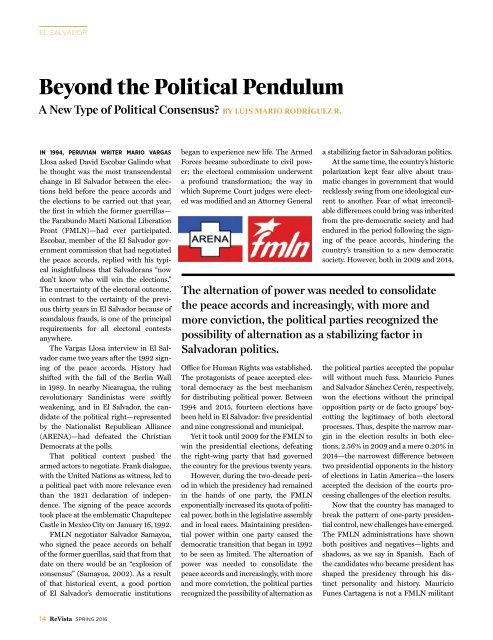EL SALVADOR
8clowSgZh
8clowSgZh
You also want an ePaper? Increase the reach of your titles
YUMPU automatically turns print PDFs into web optimized ePapers that Google loves.
<strong>EL</strong> <strong>SALVADOR</strong><br />
Beyond the Political Pendulum<br />
A New Type of Political Consensus? BY LUIS MARIO RODRÍGUEZ R.<br />
IN 1994, PERUVIAN WRITER MARIO VARGAS<br />
Llosa asked David Escobar Galindo what<br />
he thought was the most transcendental<br />
change in El Salvador between the elections<br />
held before the peace accords and<br />
the elections to be carried out that year,<br />
the first in which the former guerrillas—<br />
the Farabundo Martí National Liberation<br />
Front (FMLN)—had ever participated.<br />
Escobar, member of the El Salvador government<br />
commission that had negotiated<br />
the peace accords, replied with his typical<br />
insightfulness that Salvadorans “now<br />
don’t know who will win the elections.”<br />
The uncertainty of the electoral outcome,<br />
in contrast to the certainty of the previous<br />
thirty years in El Salvador because of<br />
scandalous frauds, is one of the principal<br />
requirements for all electoral contests<br />
anywhere.<br />
The Vargas Llosa interview in El Salvador<br />
came two years after the 1992 signing<br />
of the peace accords. History had<br />
shifted with the fall of the Berlin Wall<br />
in 1989. In nearby Nicaragua, the ruling<br />
revolutionary Sandinistas were swiftly<br />
weakening, and in El Salvador, the candidate<br />
of the political right—represented<br />
by the Nationalist Republican Alliance<br />
(ARENA)—had defeated the Christian<br />
Democrats at the polls.<br />
That political context pushed the<br />
armed actors to negotiate. Frank dialogue,<br />
with the United Nations as witness, led to<br />
a political pact with more relevance even<br />
than the 1821 declaration of independence.<br />
The signing of the peace accords<br />
took place at the emblematic Chapultepec<br />
Castle in Mexico City on January 16, 1992.<br />
FMLN negotiator Salvador Samayoa,<br />
who signed the peace accords on behalf<br />
of the former guerillas, said that from that<br />
date on there would be an “explosion of<br />
consensus” (Samayoa, 2002). As a result<br />
of that historical event, a good portion<br />
of El Salvador’s democratic institutions<br />
began to experience new life. The Armed<br />
Forces became subordinate to civil power;<br />
the electoral commission underwent<br />
a profound transformation; the way in<br />
which Supreme Court judges were elected<br />
was modified and an Attorney General<br />
Office for Human Rights was established.<br />
The protagonists of peace accepted electoral<br />
democracy as the best mechanism<br />
for distributing political power. Between<br />
1994 and 2015, fourteen elections have<br />
been held in El Salvador: five presidential<br />
and nine congressional and municipal.<br />
Yet it took until 2009 for the FMLN to<br />
win the presidential elections, defeating<br />
the right-wing party that had governed<br />
the country for the previous twenty years.<br />
However, during the two-decade period<br />
in which the presidency had remained<br />
in the hands of one party, the FMLN<br />
exponentially increased its quota of political<br />
power, both in the legislative assembly<br />
and in local races. Maintaining presidential<br />
power within one party caused the<br />
democratic transition that began in 1992<br />
to be seen as limited. The alternation of<br />
power was needed to consolidate the<br />
peace accords and increasingly, with more<br />
and more conviction, the political parties<br />
recognized the possibility of alternation as<br />
a stabilizing factor in Salvadoran politics.<br />
At the same time, the country’s historic<br />
polarization kept fear alive about traumatic<br />
changes in government that would<br />
recklessly swing from one ideological current<br />
to another. Fear of what irreconcilable<br />
differences could bring was inherited<br />
from the pre-democratic society and had<br />
endured in the period following the signing<br />
of the peace accords, hindering the<br />
country’s transition to a new democratic<br />
society. However, both in 2009 and 2014,<br />
The alternation of power was needed to consolidate<br />
the peace accords and increasingly, with more and<br />
more conviction, the political parties recognized the<br />
possibility of alternation as a stabilizing factor in<br />
Salvadoran politics.<br />
the political parties accepted the popular<br />
will without much fuss. Mauricio Funes<br />
and Salvador Sánchez Cerén, respectively,<br />
won the elections without the principal<br />
opposition party or de facto groups’ boycotting<br />
the legitimacy of both electoral<br />
processes. Thus, despite the narrow margin<br />
in the election results in both elections,<br />
2.56% in 2009 and a mere 0.20% in<br />
2014—the narrowest difference between<br />
two presidential opponents in the history<br />
of elections in Latin America—the losers<br />
accepted the decision of the courts processing<br />
challenges of the election results.<br />
Now that the country has managed to<br />
break the pattern of one-party presidential<br />
control, new challenges have emerged.<br />
The FMLN administrations have shown<br />
both positives and negatives—lights and<br />
shadows, as we say in Spanish. Each of<br />
the candidates who became president has<br />
shaped the presidency through his distinct<br />
personality and history. Mauricio<br />
Funes Cartagena is not a FMLN militant<br />
14 ReVista SPRING 2016


